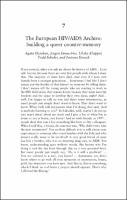Chapter 7 The European HIV/ AIDS Archive: building a queer counter- memory
| dc.contributor.author | Dziuban, Agata | |
| dc.contributor.author | Januschke, Eugen | |
| dc.contributor.author | Klöppel, Ulrike | |
| dc.contributor.author | Sekuler, Todd | |
| dc.contributor.author | Struzik, Justyna | |
| dc.date.accessioned | 2023-06-08T13:34:56Z | |
| dc.date.available | 2023-06-08T13:34:56Z | |
| dc.date.issued | 2022 | |
| dc.identifier.uri | https://library.oapen.org/handle/20.500.12657/63437 | |
| dc.description.abstract | Mobilising a queer theoretical framework, by which we mean embracing unhappiness, ephemerality, and instability, this chapter reflects on processes of archiving oral histories as part of the European HIV/AIDS Archive (EHAA). It presents selected challenges and tensions that lie at the heart of remembering, narrating, and archiving the HIV/AIDS epidemic in the broader European region. The EHAA, an online collection of oral history interviews and digitised materials, has been developed to further establish HIV/AIDS history as part of the broader social memory, so as to work through the trauma of mass death and social discrimination and to document innovations, tensions, and inconsistencies in engaging with the epidemic across the region. <br />Building on a growing interest in archiving histories of HIV activism across Europe and North America, the EHAA project dates back to efforts by the ‘AIDS History into Museums Working Group’ to preserve such histories in Germany. The project was further developed and expanded in two research projects: ‘Disentangling European HIV/AIDS Policies: Activism, Citizenship and Health’ and ‘Don’t Criminalize Passion! The AIDS Crisis and Political Mobilization in the 1980s and early 1990s in Germany’. <br />Explicitly deviating from an investment in offspring as a route for the transmission of memory, the EHAA joins other queer archival work imagined as sites for handing down queer history. This chapter argues that the EHAA contributes to queer memory work as a necessary revision of public remembrance and current perceptions of the epidemic, and, at the same time, as a source of inspiration for future activism. | en_US |
| dc.language | English | en_US |
| dc.subject.classification | thema EDItEUR::M Medicine and Nursing::MB Medicine: general issues::MBX History of medicine | en_US |
| dc.subject.classification | thema EDItEUR::M Medicine and Nursing::MJ Clinical and internal medicine::MJC Diseases and disorders::MJCJ Infectious and contagious diseases::MJCJ2 Medicine: HIV/AIDS, retroviral diseases | en_US |
| dc.subject.classification | thema EDItEUR::N History and Archaeology | en_US |
| dc.subject.classification | thema EDItEUR::3 Time period qualifiers::3M c 1500 onwards to present day::3MP 20th century, c 1900 to c 1999::3MPQ Later 20th century c 1950 to c 1999 | en_US |
| dc.subject.classification | thema EDItEUR::3 Time period qualifiers::3M c 1500 onwards to present day::3MR 21st century, c 2000 to c 2100 | en_US |
| dc.subject.classification | thema EDItEUR::N History and Archaeology::NH History::NHD European history | en_US |
| dc.subject.other | HIV/AIDS; archive; queer theory; queer counter-memory; utopia; European HIV/AIDS Archive; Europe; ephemera; affect theory; oral history | en_US |
| dc.title | Chapter 7 The European HIV/ AIDS Archive: building a queer counter- memory | en_US |
| dc.type | chapter | |
| oapen.relation.isPublishedBy | 6110b9b4-ba84-42ad-a0d8-f8d877957cdd | en_US |
| oapen.relation.isPartOfBook | d390b7c9-cbcf-45e4-945e-f0fc3e208807 | en_US |
| oapen.relation.isFundedBy | d859fbd3-d884-4090-a0ec-baf821c9abfd | en_US |
| oapen.relation.isFundedBy | d94bb91a-b658-466f-b219-dc59e8220efa | en_US |
| oapen.collection | Wellcome | en_US |

